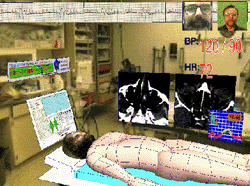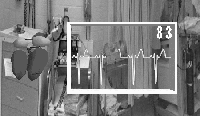Wander into the HIT Lab any Thursday afternoon and you will likely find
yourself engaged in a lively discussion of the future of medical interface
technology. These days you are also likely to find our medical advisors
(representing a broad spectrum of medical specialties from a number of area
hospitals) gathered in the sim lab, taking turns at "putting their heads
inside" a virtual emergency room.
 This replica of the Harborview trauma center was created from still images
photographed by Peter Oppenheimer and mapped as a continuous texture map onto a
cylindrical geometry, in a manner similar to Quicktime VR. This approach
provides a strong sense of presence within the simulated environment, and is
suitable for situations in which the user's virtual position remains relatively
stable. A second environment will soon be completed based on stills
Oppenheimer acquired of the 18th MASH unit while it was deployed at Ft. Lewis
earlier this year.
This replica of the Harborview trauma center was created from still images
photographed by Peter Oppenheimer and mapped as a continuous texture map onto a
cylindrical geometry, in a manner similar to Quicktime VR. This approach
provides a strong sense of presence within the simulated environment, and is
suitable for situations in which the user's virtual position remains relatively
stable. A second environment will soon be completed based on stills
Oppenheimer acquired of the 18th MASH unit while it was deployed at Ft. Lewis
earlier this year.
Inside the virtual ER, doctors and other medical personnel can grab data
objects (such as radiology images, simulated teleconsultant video, EKG
recordings, heart rhythm strips, and vital signs data) and place them anywhere
in the space. Each object can also be stabilized relative to a number of
different reference points, such as the room, the virtual patient, the user's
head, and the user's body. Objects can also be made visible or invisible at
the user's command. The objective of all this activity is to explore the
design space for medical interfaces of the future, to determine how immersive
augmented space might best be utilized.
Several recent innovations have enhanced the research
capabilities of the HITLab's clinical simulation environment:
the LIMIT (Laboratory for Integrated Medical
Interface Technology), also known as the "Virtual ER."
 During the autumn 1996 term, Dr. Stan Kaufman, HITL
medical advisor and an experienced cardiologist and
medical informatics fellow at Seattle's VA Hospital, led
a team of programmers including Edward Miller and
Ivan Poupyrev in the development of several novel
spatial representations of electrocardiogram (ECG) data.
Using the concepts of primary and secondary task
loading developed for aviation display research, the
team also implemented methods for immersively testing
the effectiveness of new display objects and presentation
styles. Results of Kaufman's studies were presented at
the Medicine Meets Virtual Reality conference in
January '97 and at the American College of Cardiology
meeting in March.
During the autumn 1996 term, Dr. Stan Kaufman, HITL
medical advisor and an experienced cardiologist and
medical informatics fellow at Seattle's VA Hospital, led
a team of programmers including Edward Miller and
Ivan Poupyrev in the development of several novel
spatial representations of electrocardiogram (ECG) data.
Using the concepts of primary and secondary task
loading developed for aviation display research, the
team also implemented methods for immersively testing
the effectiveness of new display objects and presentation
styles. Results of Kaufman's studies were presented at
the Medicine Meets Virtual Reality conference in
January '97 and at the American College of Cardiology
meeting in March.
With waveform data stream capability represented by
the ECG, the LIMIT team is now focusing on immersive
simulation of advanced interfaces for radiology tasks,
incorporating the Lab's tablet-based "working surfaces"
Stretching the LIMIT approach for image selection, processing and annotation.
Dr. David Haynor, UW radiologist and a long-time
HITLab medical advisor, is providing domain guidance
and appropriate image data for this activity.
In addition to cardiology and radiology, data elements
relevant to general surgery will also be incorporated
into the LIMIT over the next six months, under a
DARPA-sponsored project with Prof. Blake Hannaford
(director of the UW Biorobotics Lab) and Dr. Mika Sinanan (director of the UW Center for Videoendoscopic Surgery).
The LIMIT testbed was featured in Olympia, WA at a legislative
reception sponsored by the Washington Technology Center and the
Association of Washington Business. Using Poupyrev's nonlinear "go-go"
reaching metaphor, participants were able to grab and relocate
clinical data objects, such as x-rays and Kaufman's spatial ECG model,
in an immersive version of the Harborview Medical Center emergency
room. The demonstration effectively conveyed the potential of VR as a
medical interface prototyping environment.
 This replica of the Harborview trauma center was created from still images
photographed by Peter Oppenheimer and mapped as a continuous texture map onto a
cylindrical geometry, in a manner similar to Quicktime VR. This approach
provides a strong sense of presence within the simulated environment, and is
suitable for situations in which the user's virtual position remains relatively
stable. A second environment will soon be completed based on stills
Oppenheimer acquired of the 18th MASH unit while it was deployed at Ft. Lewis
earlier this year.
This replica of the Harborview trauma center was created from still images
photographed by Peter Oppenheimer and mapped as a continuous texture map onto a
cylindrical geometry, in a manner similar to Quicktime VR. This approach
provides a strong sense of presence within the simulated environment, and is
suitable for situations in which the user's virtual position remains relatively
stable. A second environment will soon be completed based on stills
Oppenheimer acquired of the 18th MASH unit while it was deployed at Ft. Lewis
earlier this year.
 During the autumn 1996 term,
During the autumn 1996 term,